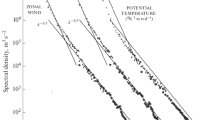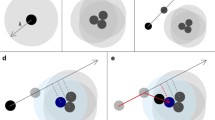Abstract
Fractals and multifractals are a natural consequence of self-similarity resulting from scale-independent processes. Multifractals are spatially intertwined fractals which can be further grouped into two classes according to the characteristics of their fractal dimension spectra: continuous and discrete multifractals. The concept of multifractals emphasizes spatial associations between fractals and fractal spectra. Distinguishing discrete multifractals from continuous multifractals makes it possible to describe discrete physical processes from a multifractal point of view. It is shown that multiplicative cascade processes can generate continuous multifractals and that Markov processes result in discrete multifractals. The latter result provides not only theoretical evidence for existence of discrete multifractals but also a fundamental model illustrating the general properties of discrete multifractals. Classical prefractal examples are used to show how asymmetrical Markov process can be applied to generate prefractal sets and discrete multifractals. The discrete multifractal model based on Markov processes was applied to a dataset of gold deposits in the Great Basin, Nevada, USA. The gold deposits were regarded as discrete multifractals consisting of three spatially interrelated point sets (small, medium, and large deposits) yielding fractal dimensions of 0.541 for the small deposits (<25 tons Au), 0.296 for the medium deposits (25--500 tons Au), and 0.09 for the large deposits (>500 tons Au), respectively.
Similar content being viewed by others
REFERENCES
Agterberg, F. P., 1993, Calculation of the variance of mean values for blocks in regional resource evaluation studies: Nonrenewable Resources, v. 2, no. 4, p. 312–324.
Agterberg, F. P., 1994, Fractals, multifractals, and change of support, in Dimitrakopoulos, R., ed., Geostatistics for the next century: Kluwer Academic Publ., Dordrecht, p.223–234.
Agterberg, F. P., 1997, How nature works: The science of self-organized criticality, by Per Bak, book review: Computers & Geosciences, v. 24, no. 2, p. 205–207.
Agterberg, F. P., Cheng, Q., and Wright, D. F., 1993, Fractal modeling of mineral deposits, in Elbrond, J., and Tang, X., eds., Application of computers and operations research in the mineral industry: Proc. 24th APCOM Symposium (Montreal), Can. Inst. Mining, Metallurgy and Petroleum Eng., v. 1, p. 43–53.
Andrle, R., 1996, Complexity and scale in geomorphology: Statistical self-similarity vs. characteristics scales: Math. Geology, v. 28, no. 3, p. 275–293.
Atmanspacher, H., Scheingraber, H., and Wiedenmann, G., 1989, Determination of f (α) for a limited random point set, Phys. Rev., v. 40, p. 3954–3963.
Bak, P., 1996, How nature works: Springer-Verlag, New York, 212 p.
Cheng, Q., 1994, Multifractal modeling and spatial analysis with GIS: Gold potential estimation in the Mitchell-Sulphurets area, northwestern British Columbia: unpubl. doctoral dissertation, The School of Graduate Studies and Research of Univ., Ottawa, 268 p.
Cheng, Q., 1997a, Discrete multifractals: Math. Geology, v. 29, no. 2, p. 245–266.
Cheng, Q., 1997b, Fractal ?multifractal modeling and spatial analysis, in V. Pawlowsky-Glahn, ed., Proc. IAMG'97: Barcelona, Spain, Sept. 22–27, v. 1, p. 57–72.
Cheng, Q., and Agterberg, F. P., 1995, Multifractal modeling and spatial point processes: Math. Geology, v. 27, no. 7, p. 831–845.
Cheng, Q., and Agterberg, F. P., 1996a, Multifractal modeling and spatial statistics: Math. Geology, v. 28, no. 1, p. 1–16.
Cheng, Q., and Agterberg, A. F., 1996b, Comparison between two types of multifractal modeling: Math. Geology, v. 28, no. 8, p. 1001–1015.
Cheng, Q., Agterberg, F. P., and Ballantyne, S. B., 1994, The separation of geochemical anomalies from background by fractal methods: Jour. Geochemical Exploration, v. 51, no. 2, p. 109–130.
Chhabra, A. B., and Sreenivasan, K. R., 1991, Negative dimensions: Theory, computation and experiment: Phys. Rev. A, v. 43, no. 2, p. 1114–1117.
ESRI Inc., 1996, ARC ?INFO Unix Version 7.
Evertsz, C. J. G., and Mandelbrot, B. B., 1992, Multifractal measures, in Peitgen, H.-O., Jörgens, H., and Saupe, D., eds., Chaos and fractals: Springer-Verlag, New York, p. 922–953.
Feder, J., 1988, Fractals: Plenum, New York, 283 p.
Gupta, V. K., and Waymire, E. C., 1993, A statistical analysis of mesoscale rainfall as a random cascade: American Meteorological Society, v. 32, p. 251–267.
Halsey, T. C., Jensen, M. H., Kadanoff, L. P., Procaccia, I., and Shraiman, B. I., 1986, Fractal measures and their singularities. The characterization of strange sets: Phys. Rev. A, v. 33, no. 2, p. 1141–1151.
Lavallée, D., Schertzer, D., and Lovejoy, S., 1991, On the determination of the codimension function, in Schertzer, D., and Lovejoy, S., eds., Non-linear variability in geophysics: Kluwer Academic Publ., Dordrecht, p. 99–109.
Lovejoy, S., and Schertzer, D., 1991, Multifractal analysis techniques and the rain and cloud fields from 10?3 to 106 m, in Schertzer, D., and Lovejoy, S., eds., Non-linear variability in geophysics: Kluwer Academic Publ., Dordrecht, p. 111–144.
Mandelbrot, B. B., 1983, The fractal geometry of nature (updated and augmented edition): W. H. Freeman and Company, New York, 468 p.
Mandelbrot, B. B., and Evertsz, C. J. G., 1991, Exactly self-similar left-sided multifractals, in Bunde, A., and Havlin, S., eds., Fractals and disordered systems: Springer Verlag, Heidelberg, p. 323–344.
Meneveau, C., and Sreenivasan, K. R., 1987, Simple multifractal cascade model for fully developed turbulence: Phys. Rev. Lett., v. 59, no. 13, p. 1424–1427.
Schertzer, D., and Lovejoy, S., 1987, Physically based rain and cloud modeling by anisotropic, multiplicative turbulent cascades: J. Geophys. Res., v. 92, no. D8, p. 9693–9714.
Schertzer, D., and Lovejoy, S., eds., 1991a, Non-linear variability in geophysics: Kluwer Academic Publ., Dordrecht, 318 p.
Schertzer, D., and Lovejoy, S., 1991b, Nonlinear geodynamical variability: Multiple singularities, universality and observations, in Schertzer, D., and Lovejoy, D., eds., Non-linear variability in geophysics: Kluwer Academic Publ., Dordrecht, p. 41–82.
Schertzer, D., and Lovejoy, S., 1992, Hard and soft multifractal processes: Physica A, v. 185, nos. 1–4, p. 187–194.
Stanley, H., and Meakin, P., 1988, Multifractal phenomena in physics and chemistry: Nature, v. 335, no. 6189, p. 405–409.
Author information
Authors and Affiliations
Rights and permissions
About this article
Cite this article
Cheng, Q. Markov Processes and Discrete Multifractals. Mathematical Geology 31, 455–469 (1999). https://doi.org/10.1023/A:1007594709250
Issue Date:
DOI: https://doi.org/10.1023/A:1007594709250




